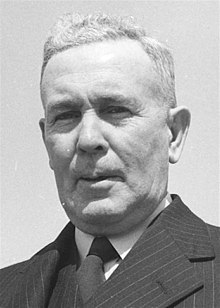Ben Chifley | |
|---|---|
 Chifley in 1948 | |
| 16th Prime Minister of Australia | |
| In office 13 July 1945 – 19 December 1949 | |
| Monarch | George VI |
| Governors‑General | The Duke of Gloucester Sir William McKell |
| Deputy | Frank Forde Herbert Evatt |
| Preceded by | Frank Forde |
| Succeeded by | Robert Menzies |
| Leader of the Labor Party | |
| In office 13 July 1945 – 13 June 1951 | |
| Deputy | Frank Forde Herbert Evatt |
| Preceded by | John Curtin |
| Succeeded by | Herbert Evatt |
| Treasurer of Australia | |
| In office 7 October 1941 – 18 December 1949 | |
| Prime Minister | John Curtin Frank Forde Himself |
| Preceded by | Arthur Fadden |
| Succeeded by | Arthur Fadden |
| Leader of the Opposition | |
| In office 19 December 1949 – 13 June 1951 | |
| Prime Minister | Robert Menzies |
| Deputy | Herbert Evatt |
| Preceded by | Robert Menzies |
| Succeeded by | Herbert Evatt |
| Minister for Postwar Reconstruction | |
| In office 22 December 1942 – 2 February 1945 | |
| Prime Minister | John Curtin |
| Preceded by | Office Created |
| Succeeded by | John Dedman |
| Minister for Defence | |
| In office 3 March 1931 – 6 January 1932 | |
| Prime Minister | James Scullin |
| Preceded by | John Daly |
| Succeeded by | George Pearce |
| Member of the Australian Parliament for Macquarie | |
| In office 21 September 1940 – 13 June 1951 | |
| Preceded by | John Lawson |
| Succeeded by | Tony Luchetti |
| In office 17 November 1928 – 19 December 1931 | |
| Preceded by | Arthur Manning |
| Succeeded by | John Lawson |
| Personal details | |
| Born | Joseph Benedict Chifley 22 September 1885 Bathurst, Colony of New South Wales |
| Died | 13 June 1951 (aged 65) Canberra, Australia |
| Political party | Labor |
| Other political affiliations | Industrial Labor (1938–1939) |
| Spouse | |
| Education | Limekilns Public School Patrician Brothers' School, Bathurst |
| Occupation | Engine driver (New South Wales Railways) |
| Signature |  |
| ||
|---|---|---|
Term of government (1945–1949)
Ministries Elections |
||
Joseph Benedict Chifley (/ˈtʃɪfli/;[1] 22 September 1885 – 13 June 1951) was an Australian politician and train driver who served as the 16th prime minister of Australia from 1945 to 1949. He held office as the leader of the Australian Labor Party (ALP), having previously served as the treasurer of Australia under Prime Minister John Curtin and later himself from 1941 to 1949. He was notable for defining Australia's post-war reconstruction efforts.
Chifley was born in Bathurst, New South Wales, and joined the New South Wales Government Railways after leaving school, eventually qualifying as an engine driver. He was prominent in the trade union movement before entering politics, and was also a director of The National Advocate. After several previous unsuccessful candidacies, Chifley was elected to parliament in the 1928 federal election. In 1931, he was appointed Minister for Defence in the government of James Scullin. He served in cabinet for less than a year before losing his seat at the 1931 federal election, which saw the government suffer an electoral wipeout.
After his electoral defeat, Chifley remained involved in politics as a party official, siding with the federal Labor leadership against the Lang Labor faction. He served on a royal commission into the banking system in 1935, and in 1940 became a senior public servant in the Department of Munitions. Chifley was re-elected to parliament later that year, on his third attempt since 1931. He was appointed Treasurer in the new Curtin government in 1941, as one of the few Labor MPs with previous ministerial experience. The following year Chifley was additionally made Minister for Postwar Reconstruction, making him one of the most powerful members of the government. He became prime minister following Curtin's death in office in 1945, defeating caretaker prime minister Frank Forde in a leadership ballot.
At the 1946 Australian federal election, Chifley was re-elected with a slightly reduced majority – the first time that an incumbent Labor government had won re-election. The war had ended a month after he took office, and over the following three years his government embarked on an ambitious program of social reforms and nation-building schemes. These included the expansion of the welfare state, increased the post-war immigration to Australia, and the establishment of the Australian National University, the Australian Security Intelligence Organisation (ASIO), and the Snowy Mountains Scheme. Some of the new legislation was successfully challenged in the High Court, and as a result the constitution was amended to give the federal government extended powers over social services.
Some of Chifley's more interventionist economic policies were poorly received by Australian business, particularly an attempt to nationalise banks. His government was defeated at the 1949 Australian federal election, which brought Robert Menzies' Liberal Party to power for the first time. He stayed on as Leader of the Opposition until his death, which came a few months after the 1951 Australian federal election; Labor did not return to government until 1972. For his contributions to post-war prosperity, Chifley is often regarded as one of Australia's greatest prime ministers. He is held in particularly high regard by the Labor Party, with his "light on the hill" speech seen as seminal in both the history of the party and the broader Australian labour movement.
